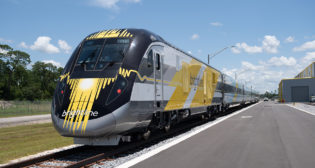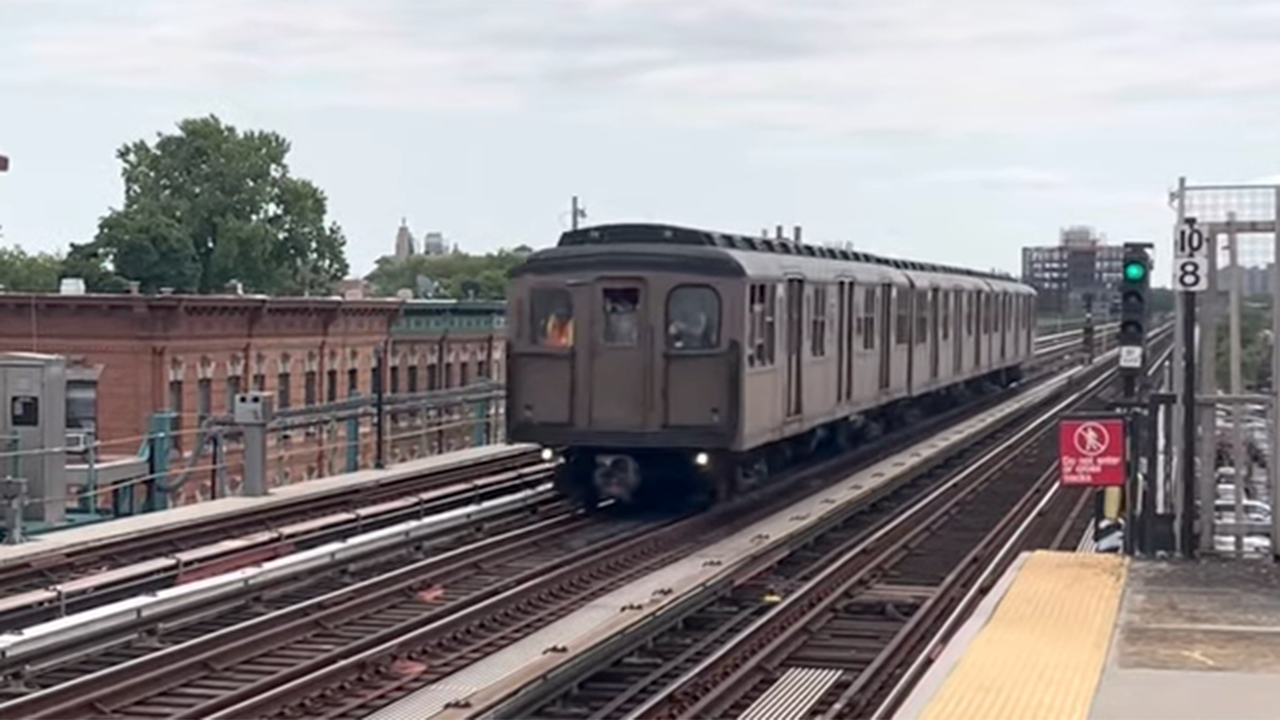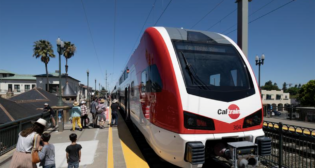
New York MTA Marks BMT Centennial
Written by David Peter Alan, Contributing Editor
Screen Shot of a YouTube video by Retired Railfan Horn Guy
The Brooklyn-Manhattan Transit Corporation (BMT) was founded 100 years ago, on June 15, 1923, and New Yorkers gathered in Brooklyn to celebrate by riding on a train that was even older and had seen most of its service on BMT rails. The event was sponsored by the New York Metropolitan Transportation Authority (MTA) and the New York City Transit Museum. It was held on short notice, but that did not keep New York subway fans from showing up to ride a train that featured a view out the front window and the sound of traction motors on the elevated track above McDonald Avenue.

As a corporate entity, the BMT had a short life, just a few days less than 17 years. On June 12, 1940, it merged with the other entities that ran New York City’s subway and elevated lines: the Interborough Rapid Transit Company (IRT, which ran elevated lines and also opened the city’s first subway line in 1904) and the Independent Subway System (IND, which was owned by the City and began service in 1932). Still, the City’s oldest seniors and transit fans everywhere remember the BMT. To them, it still lives.

The special commemorative train consisted of three 1916-vintage cars built for the BMT’s predecessor, the Brooklyn Rapid Transit Company (BRT), numbered 2390, 2391 and 2392, and used occasionally for special events. They sport the trappings of the times: rattan seats, glass shades over the lights, and ceiling fans. They were the Standards, built between 1915 and 1924, and coded AB. They ran all over Brooklyn and ventured into Manhattan on the Broadway Line to 57th Street (now the N, Q, R, and W Trains), and on the 14th Street Canarsie Line (now the L Train). They last ran in revenue service in 1969 on the L Train and on Myrtle Avenue through Brooklyn and into Queens on the M Train.

For the event, the train shuttled between Kings Highway and 18th Avenue on the Culver Line, the 5 Train under the BMT’s 1924 numbering system and now part of the F Train route. The line has three tracks, an artifact of a former express service. The special train ran on the center track, bypassing four stops. The train was waiting at Kings Highway by 11:00, and the first run left Kings Highway at 11:54. Service for the “special” ended at 2:30. The ride took about six minutes each way.
“The Brooklyn Manhattan Transit Corp. led the way for the modern subway system with state-of-the-art railcars and routes that we still use today,” MTA New York City Transit President Richard Davey said. “Experiencing this piece of history with nostalgia train rides is a great reminder that the subway has been the lifeblood of New York City for generations.”
While there was no official ceremony connected with the event, Davey spoke to reporters inside the front of the train, near the cab, before the first run began: “This allows us to appreciate and celebrate history. There’s a lot of transit history in New York City.” He noted that, when the fare went from a nickel to a dime, “people went nuts” and compared that situation to events today, adding ,“I still think we’re the best game in town.” Concerning crime in the subways, Davey said that that it’s “the lowest it’s been in three or four decades” and he also praised the new open-gangway cars that are starting to make their appearance on the system. He stayed on the train for the first ride, and as the special pulled ahead of an F Train in regular revenue service, he exclaimed, “Look! We’re winning!”
“There is no better way for the New York Transit Museum to celebrate the BMT’s Centennial than by returning an iconic BMT train to the rails,” said New York Transit Museum Director Concetta Bencivenga. “Although the BMT only existed for 17 years before the systems were united in 1940, the company made a huge impact. Whether the BMT Triplex, the first articulated subway car in North America, or the focus on new and better passenger and operator experiences, these milestones and technological advancements left a legacy.”
Transit Museum Curator Judy Shapiro provided some history and background about the BMT. She told Railway Age that its predecessor, the BRT, started in 1896 as a holding company that bought up streetcar lines and small railroads in Brooklyn. The beginning of the end for the BRT came on Nov. 1, 1918, when a speeding train of wooden cars derailed in a tunnel on the Brighton Line. Ninety-three people were killed in the accident, known as the “Malbone Street Wreck,” the deadliest in the system’s history. “Malbone did a lot of damage, and the BMT took the BRT out of receivership” and took over paying the claims from the accident, Shapiro noted, adding that the BMT was profitable, even if only slightly above breaking even, through the Depression and up until the end.
As the train shuttled back and forth, many of the New Yorkers and visitors on board, from teenagers and families with kids to seniors, looked out the open windows and talked about the city’s transit system, which they considered very special.

Among them was Eddie Abreu, a Queens resident who came dressed to honor the bygone era, decked out in a dark jacket, tweed vest, black bow tie and fedora hat, and carrying Nicolas Slonimsky’s 1,500-page treatise on the history of music since 1900. He wanted to talk mostly about music theory and composition, and the “symphonic jazz” idiom that had caught on to some extent, during the era when the BMT was an independent transit provider. “As a rail enthusiast, I’m glad to see so many people riding these wonderful trains,” he said. The BMT was “the precursor of things to come when it came to widening the scope of the subway system.” The event “gives you the feeling of old New York as it was” and “makes us feel good about ourselves.” With the monumental financial challenges now facing transit in New York and other cities, perhaps Abreu’s concluding remark provided a good reason why New Yorkers turned out despite short notice to celebrate the BMT.
View the New York MTA video
View a Retired Railfan Horn Guy YouTube video of the event:
Further Reading: Development and Operation of New York’s IRT and BMT and The BMT: A Technical and Operational History, by Railway Age Contributing Editor Alfred E. Fazio.



